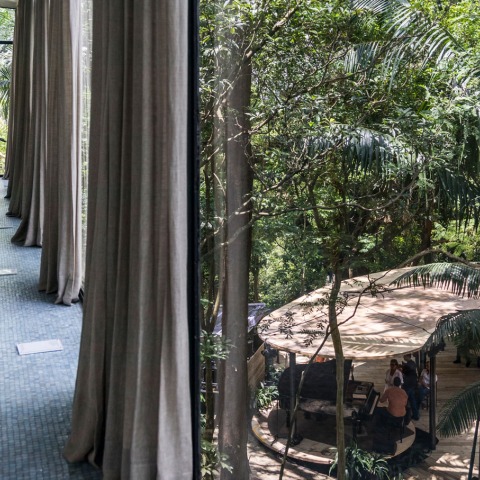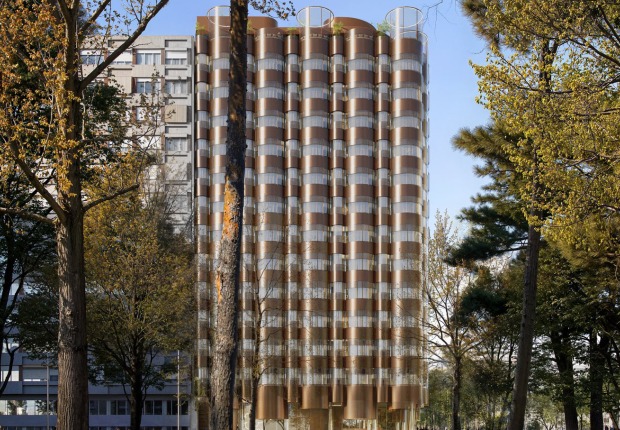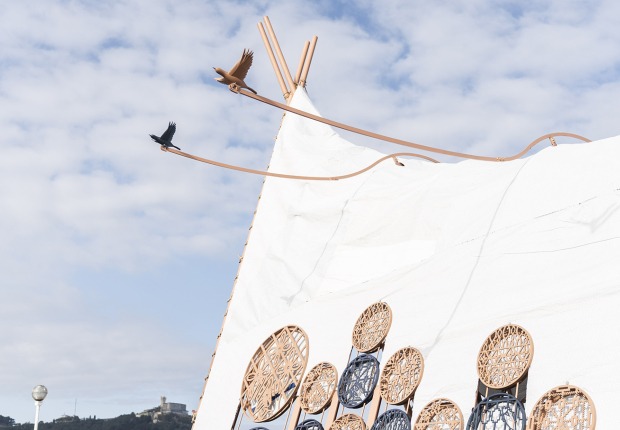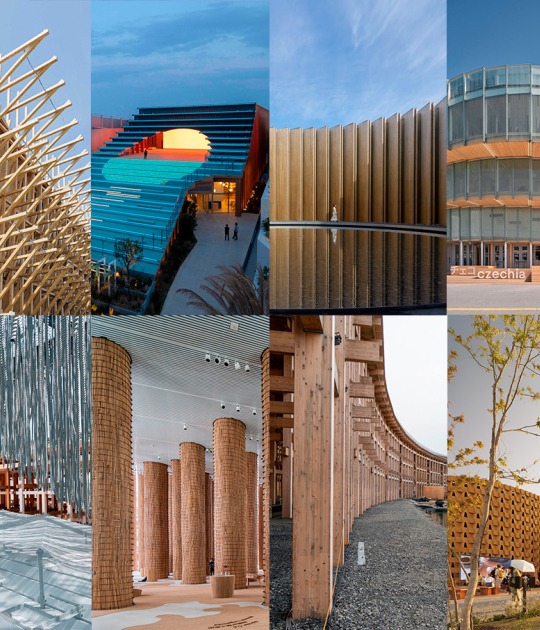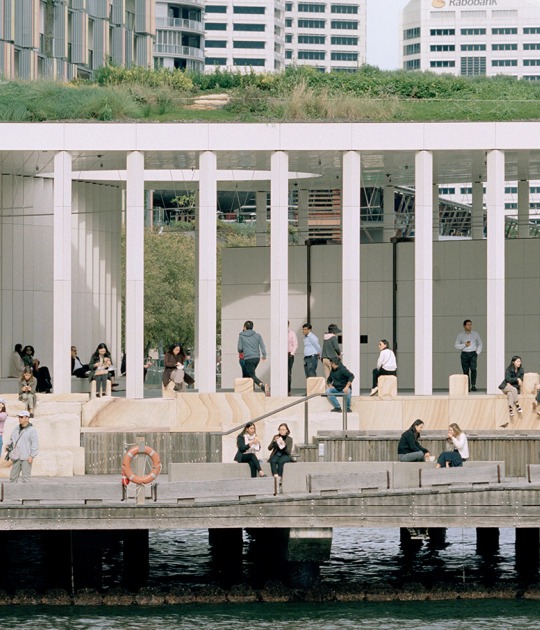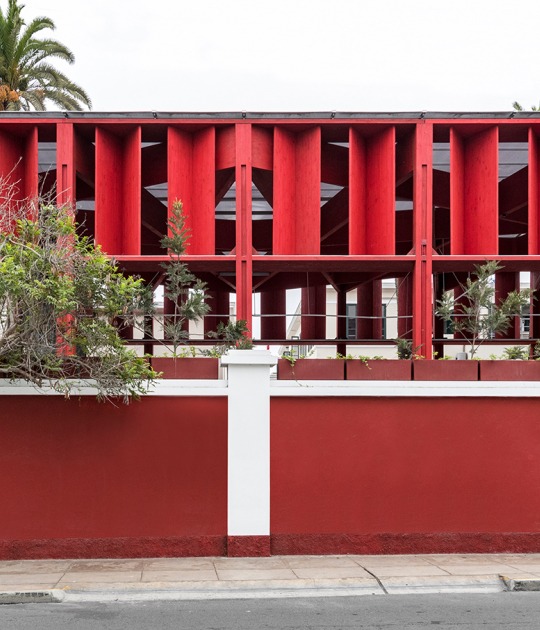"This residence represents an attempt of communion between the nature and the natural order of things, opposing to the natural elements the least number of means of defense." - Lina Bo Bardi in 1958. * “With these words I started the project, Lina thought and designed her house in total interaction with nature. She created, planted and took care of the garden of the Glass House for four decades. The garden and the house complement each other. The pavilion had to follow this idea."
Sol Camacho was firstly inspired by Lina Bo Bardi ’s designs of ephemeral structures and other architecture projects like the Quati restaurant in Salvador de Bahia. The pavilion’s organic lines draw from a careful study of the surrounding trees, the access to the Studio, and the stone ramp where it sits, following the possibilities of space while offering new relationships with the Glass House and a closer proximity to magnificent trees.
Placing for the first time a new structure close to the Glass House and inserted in the garden was a big challenge. It seemed to have almost no room for it. All trees were measured and the idea of the platform surpassing the existing stone ramp, in some moments incorporating the trees was the answer to the site. “The sinuous lines that define the border and benches came almost naturally just by sketching the possibilities of the platform’s overhang. The resulting ‘ameba’ quickly related with the surrounding low retaining walls and handrail that Lina designed for the garden. The idea of the black pillars merging as trees and sustaining the wooden canopy also follows the logic of blending with the context,” said Sol Camacho
Pietro Bardi and Lina Bo Bardi, founders of the Instituto, were big cultural promoters in all areas of the arts. The pavilion in this way continues the mission of promoting cultural and educational activities in a new open space that can receive from small groups up to 220 guests. Music and dance performances, lectures on architecture, arts and design, courses on drawing, gardening and even culinary events, for adults and children are part of the diverse program.
The pavilion is also an opportunity for regular visitors to the Glass House to spend more time in its garden, have a coffee or lunch and be inspired by the place.
“The pavilion is a temporary intervention in the House and its temporality is an essential part of the project. The design, framing the house, and the choice of the material was also important within the context of this preserved heritage site. The Glass House is listed in all instances of the heritage organizations of Brazil since 1986." affirmed Sonia Guarita - president of the Board.
A private opening of this ephemeral architecture was a big success, hosting the first ever fundraising event for the Instituto where the local celebrity Maria Bethânia sang for the audience of 250 guests. The public opening will be this Sunday 16th with a Ballet performance from the community of Paraisópolis.
Placing for the first time a new structure close to the Glass House and inserted in the garden was a big challenge. It seemed to have almost no room for it. All trees were measured and the idea of the platform surpassing the existing stone ramp, in some moments incorporating the trees was the answer to the site. “The sinuous lines that define the border and benches came almost naturally just by sketching the possibilities of the platform’s overhang. The resulting ‘ameba’ quickly related with the surrounding low retaining walls and handrail that Lina designed for the garden. The idea of the black pillars merging as trees and sustaining the wooden canopy also follows the logic of blending with the context,” said Sol Camacho
"The intention of activating other spaces of the House, while Casa de Vidro hosts MASP exhibition Sonia Gomes - Still I rise in its main salon, triggered the idea of building a temporary structure in its garden to present a diverse cultural program and a big fundraising event."
Waldick Jatobá - Executive Director of Instituto Bardi.
Pietro Bardi and Lina Bo Bardi, founders of the Instituto, were big cultural promoters in all areas of the arts. The pavilion in this way continues the mission of promoting cultural and educational activities in a new open space that can receive from small groups up to 220 guests. Music and dance performances, lectures on architecture, arts and design, courses on drawing, gardening and even culinary events, for adults and children are part of the diverse program.
The pavilion is also an opportunity for regular visitors to the Glass House to spend more time in its garden, have a coffee or lunch and be inspired by the place.
“The pavilion is a temporary intervention in the House and its temporality is an essential part of the project. The design, framing the house, and the choice of the material was also important within the context of this preserved heritage site. The Glass House is listed in all instances of the heritage organizations of Brazil since 1986." affirmed Sonia Guarita - president of the Board.
A private opening of this ephemeral architecture was a big success, hosting the first ever fundraising event for the Instituto where the local celebrity Maria Bethânia sang for the audience of 250 guests. The public opening will be this Sunday 16th with a Ballet performance from the community of Paraisópolis.
*Manuscript edited for the first time in the course of architecture of the Faculty of Fine Arts of the Federal University of Bahia in 1958. Republished in Lina Por Escrito, Textos Escolhidos of Lina Bo Bardi 1943-1991. Silvana Rubino and Marina Grinover (org)
